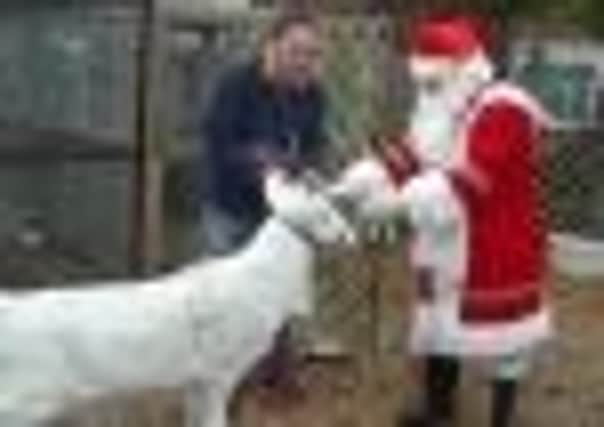Snowy takes the lead pulling along farm


For children, tonight’s the night when Dasher, Dancer, Prancer, Vixen, Comet, Cupid, Donner and Blitzen take to the skies to pull Santa’s sleigh, led by Rudolph. But one special young reindeer has already been supporting Father Christmas in a practical way during December in Whitby – as a star attraction.
Visitors have flocked to see Snowy at Victoria Farm on the edge of the North York Moors. She’s just six months old and is a very rare thing, a white reindeer.
Advertisement
Hide AdAdvertisement
Hide AdDairy farmer-turned-garden centre proprietor Mark Noble started his herd at the family’s 177-acre Dean Hall farm in Littlebeck five years ago, having diversified from farming.
“I’m told that every now and then, maybe once in every ten thousand, you’ll get a white reindeer,” says Mark.
“She’s not albino as she has dark eyes and dark skin. She just has a white coat. I guess we’re just lucky to have had the right mix of genes to produce one. Everyone who comes here has been enchanted.
“We’ve had interest from all over the world. ABC TV in America are wanting to come over and film her and we had a call from the Netherlands where a photographer who specialises in taking pictures of white animals on white backgrounds wants to come over in the New Year.”
Advertisement
Hide AdAdvertisement
Hide AdSnowy isn’t yet her real name. The Noble family – Mark’s mum and dad, Jean and Bill, and brother Paul – are running a competition asking for appropriate suggestions.
They are hopeful that Snowy’s eventual name, to be announced later today, will be something a little more imaginative.
Mark originally purchased two reindeer from an importer based in Surrey and now breeds all his own stock.
He started the herd as an attraction to sell more Christmas trees but it is now becoming a useful sideline in its own right.
Advertisement
Hide AdAdvertisement
Hide AdHe sells to buyers across the country. The market price for a reindeer is between £1,000-£1,200 and, having traded in sheep and cattle previously Mark understands the value of stockmanship.
“Being from a farming background has certainly helped. It’s all about looking after your livestock. At the moment there are lots of people who want reindeer as pets or to help as an attraction to their business.
“Reindeer are quite docile, so they’re reasonably easy to keep. But they do have quite a delicate digestive system, so you’ve got to know what you’re doing. If they eat too much grass their stomachs cannot handle it. Rich, wet proteins go straight through them.
“My wife, Rebecca, organises most of the feeding. When we first started with them we bought a special zoo mix which cost an arm and a leg. But Rebecca now spends time chatting in on-line forums with other reindeer keepers about what theirs are doing well on, and we now make up our own mix. At the moment we’re using sugar beet, cattle nuts and hay.”
Advertisement
Hide AdAdvertisement
Hide AdMale reindeer, rather like male deer, are extremely territorial over their females and reindeer bulls do not get on together. Mark’s solution is to sell on the surplus bull calves.
“We couldn’t keep two bulls on the farm over at Littlebeck because they are just so aggressive. If they were in the same area they would try and get to each other and fight. We only bring the yearling calves or the older females. There’s no way you can bring the fully-grown males.”
Mating is from late September to early November and in the wild this is when the males battle for access to the females and lock antlers. The most dominant males collect 15-20 females.Both sexes grow antlers.
Isn’t it too warm for them over here in the summer? Apparently not. “They shed their coats in the summer and it’s probably colder in England at times than it is in their own native lands,” says Mark.
Advertisement
Hide AdAdvertisement
Hide Ad“They hate being wet and want cover when it rains or snows.”
Large populations of wild reindeer are still found in Norway, Finland, Siberia, Greenland, Alaska and Canada, where they are also known as caribou. There’s also a herd of 150-170 in the Cairngorms in Scotland.
Reindeer hooves adapt to the season. In summer when the tundra is soft and wet their footpads become sponge-like. In winter the pads shrink and tighten exposing the rim of the hoof which cuts into ice and snow to stop slipping.
Wild reindeer hunting and herding of semi-domesticated reindeer for meat, hides, antlers and milk is important to several Arctic and Sub-Arctic peoples.
Advertisement
Hide AdAdvertisement
Hide AdIt was not quite that cold this week up where Bill farms. As far as hardship goes, he doesn’t miss the family’s dairy farming days, which he had been involved with since they moved to Dean Hall.
“I farmed all my life. I used to go to school after I’d done the milking, but we got down to 12.5ppl for our milk and it was just no good for any of us.
“This is far better and at least we can see a return on what we do.”
The origins of Rudolph and friends
Santa’s eight reindeer first appeared in a poem called Account of a Visit from St. Nicholas written in 1807 by Major Henry Livingston, Jr.
Advertisement
Hide AdAdvertisement
Hide AdRudolph the red-nosed reindeer was added to the original line-up by Robert L. May in 1939. He needed to create a character for a colouring book and considered giving it the names Rollo and Reginald before settling on Rudolph.
The character was an instant hit and after the war May’s brother-in-law, Johnny Marks, wrote the song which Bing Crosby recorded in 1950. It proved to be a hit for him and for many other artists to the present day.